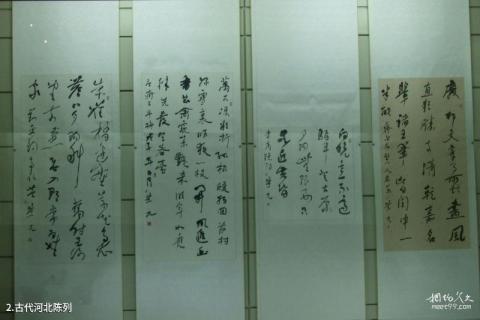
Introduction to ancient Hebei display: The starting and ending time range is from the prehistoric period to the Qing Dynasty (before the Opium War), with an exhibition area of 1,300 square meters and a display line of 220 meters. More than 600 cultural relics and more than 170 pictures are on display. Auxiliary exhibits include charts, rubbings, restored landscapes, computer touch screens, etc. The display content is divided into six parts: prehistoric period, Xia, Shang and Western Zhou dynasties, Spring and Autumn and Warring States periods, Qin, Han, Wei, Jin, Southern and Northern Dynasties, Sui, Tang, Five Dynasties, Song, Liao and Jin periods, and Yuan, Ming and Qing dynasties, with a total of 23 units. In the prehistoric period, ancient human remains in the Yangyuan Nihewan Basin prove that ancient Hebei was one of the birthplaces of mankind, and the Cishan culture among the primitive settlements is highlighted. The Xia, Shang and Western Zhou dynasties show the activities of the Shang ancestors in ancient Hebei, the Shang Dynasty moving its capital to Xing, and the Fang and feudal states at that time. During the Spring and Autumn Period and the Warring States Period, it tells the story of the generous tragedy of the three feudal vassal states of Yan, Zhao and Zhongshan conquering each other against the historical background of war and integration. The Qin, Han, Wei, Jin, Southern and Northern Dynasties show the development of agriculture and iron smelting in Hebei when the Qin and Han Dynasties were unifying, the rise and fall of Yecheng, the ancient capital of the Six Dynasties, the development of the power of aristocratic families, and the spread of Buddhism. The Sui, Tang, Five Dynasties, Song, Liao and Jin dynasties show the establishment of Hebei Province in the Tang Dynasty, Hebei began to be an administrative region of China, the Northern Song Dynasty and the Liao Dynasty coexisted in Hebei, the Jin regime unified the historical context of Hebei, and the glory of the four major porcelain kilns of Xing Kiln, Ding Kiln, Cizhou Kiln and Jingxing Kiln Achievement. During the Yuan, Ming and Qing dynasties, it summarizes the historical evolution and changes in Hebei during the nearly 700 years of the three dynasties in terms of the Great Wall, an important military barrier in the north during the period when Hebei was the center of Jifu, and the Summer Resort in Chengde, the summer capital of the Qing Dynasty.
